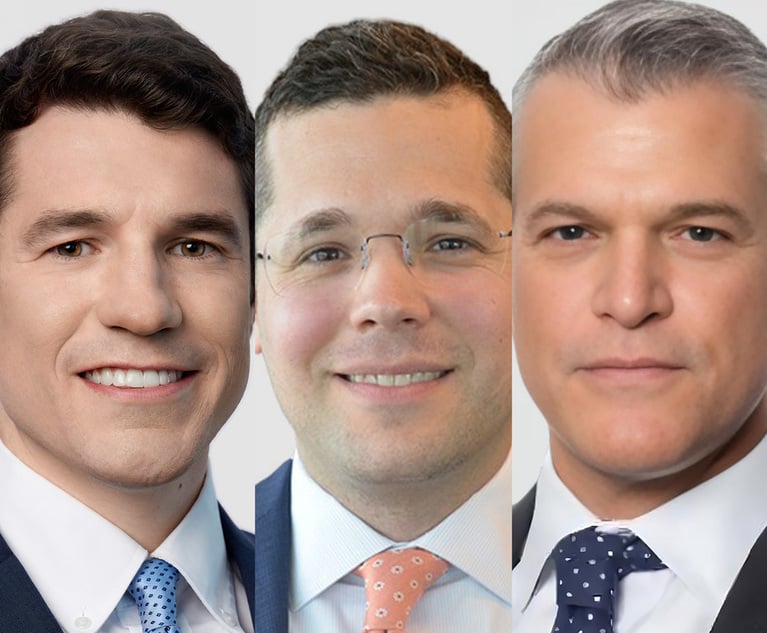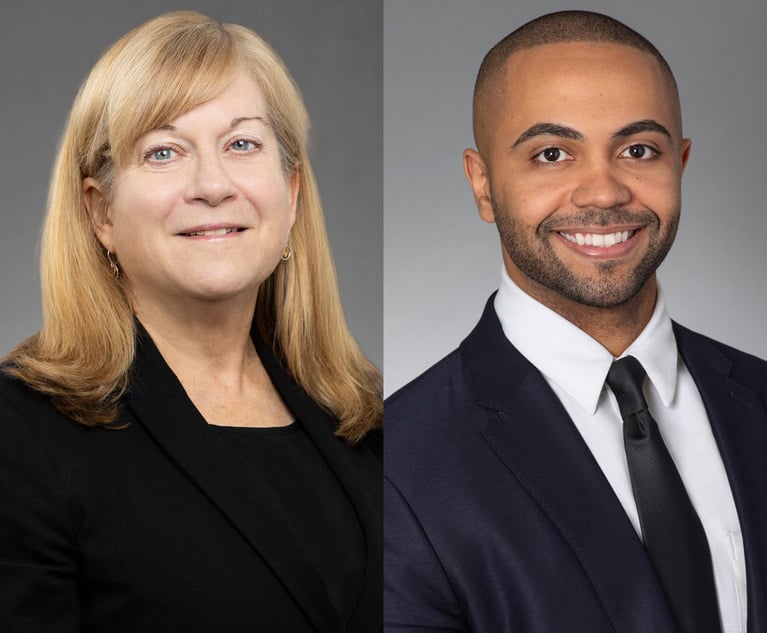 Nicolas Watkins, shareholder GrayRobinson, Miami (Photo: Courtesy Photo)
Nicolas Watkins, shareholder GrayRobinson, Miami (Photo: Courtesy Photo)Hiring a Foreign Worker? No Problem. You Just Need to Know What to Expect
If you plan properly, the work authorization and on-boarding processes, even when hiring a foreign employee, can be as smooth as they will be for a U.S. worker.
January 23, 2020 at 10:02 AM
6 minute read
Hiring employees is no fun when you consider the costs (Social Security contributions, unemployment taxes, health insurance, 401(k) benefits) and the issues that might arise during the course of the employment relationship (potential liability for accidents occurring on the job, sexual discrimination claims, termination issues). Hiring a foreign worker can be even more difficult when you consider that one of the first steps in the hiring process is to ensure that the foreign national has an appropriate work visa. However, if you plan properly, the work authorization and on-boarding processes, even when hiring a foreign employee, can be as smooth as they will be for a U.S. worker.
|Which Work Visa?
When hiring a foreign employee, the first step is for the employer to sponsor the worker for the appropriate work visa. There are myriad visas from which to choose, but, in the business setting, the options are often limited to three: The E, H and L visas. The E-1 (treaty trader) visa is for those coming to work for a company engaging in "substantial trade." The E-2 (treaty investor) visa is for investors or their employees who are coming here to work based on a substantial investment that has been made in a U.S. enterprise. Both the E-1 and E-2 visas also require an appropriate treaty or trade agreement to be in place between the United States and the country of the foreign national's citizenship, and the U.S. enterprise must be at least 50% owned by citizens of the foreign investor's or employee's nationality.
The H-1B visa is the most often desired visa in that it permits U.S. employers to employ foreign workers in specialty occupations, that is, positions that require, at a minimum, a bachelor's degree in a specialized field such as in accounting, architecture, engineering, mathematics, computer science and the like. The employee must have the required degree or its equivalent based on work experience and education. There must also be an employer-employee relationship and the employer must pay at or above a required wage. Each year, employers file 200,000 or more petitions for as few as 85,000 available H-1B visas. So, the chances that an employer's H-1B petition will not be selected are high.
The third visa option in the business setting is the L-1 visa. This is a visa for someone who has already been working for the U.S. employer's parent, subsidiary or sister company overseas for at least a year as a manager or executive, or in a specialized knowledge position. As the L-1 intracompany visa implies, it is for multinational companies who desire to transfer managers and executives, and specialized knowledge workers, to the United States, initially on a temporary assignment.
In order to determine which visa is appropriate for a prospective foreign employee, the prospective U.S. employer must consider: The nationality of the foreign worker, whether the foreign national is coming to fill a managerial or executive position, or one that requires a bachelor's degree, and whether the employee has worked for an overseas parent, subsidiary or sister company of the prospective U.S. employer for at least a year. The employer must also consider the requirements for the job, the salary to be paid, and, of course, whether the employee actually qualifies for the position offered.
|Visa Application Process
Once the appropriate visa has been determined, the visa application process itself usually consists of two steps. For the H and L visas (but not for the E visas), the employer must first file a visa petition with U.S. Citizenship and Immigration Services (USCIS). Upon approval of the petition, the prospective employee may then apply for the visa at a U.S. embassy overseas before entering the United States to start employment. If, however, the individual is already in the United States, then the worker may sometimes request a change in status to that of the visa for which the petition has been approved.
USCIS can take several months or more to process and adjudicate a visa petition, especially if additional evidence is required to prove up the case. Employers must therefore be flexible about the prospective employment commencement date. An employer must also understand that USCIS has been known to deny what might have seemed the most approvable of petitions at the time of filing. Even if the employer's petition has been approved, consular officials at the U.S. embassy abroad could still deny the visa application due to a prior overstay, a criminal background or other grounds of inadmissibility. Neither petition nor visa approval is guaranteed. As a result, it behooves employers of foreign workers to plan early, vet their hires and submit thoroughly documented visa petitions.
Only after the foreign worker has entered the United States with the work visa, or has successfully changed to the work visa status, can he commence the sponsored employment. The on-boarding process after this is the same for U.S. and foreign workers alike.
|Form I-9
One important part of the on-boarding process is the Form I-9, employment authorization verification form, which all employers are required to complete within the first three days of an employee's hire in order to verify employment eligibility. The I-9 form itself might seem simple to complete, but it cannot be that easy, because the accompanying instructions for completing the form comprise 116 pages! Mistakes are costly: there are civil penalties for failing to complete the I-9, for failing to complete it timely, for improperly completing the form, and for employing an unauthorized worker. Further violations can occur due to an employer discriminating against a worker based on national origin or document abuse in the I-9 process.
In determining penalty amounts, five factors are taken into account: Business size, good faith effort to comply, the seriousness of the violation, whether there are unauthorized workers and the employer's history of violations. Penalties for paperwork violations range from $230 to $2,292 per violation, while penalties for knowingly hiring and continuing to employ unauthorized aliens range from $573 to $20,130 per violation. Each violation is treated separately, and all violations are aggregated, and so the fines add up fast, particularly for larger employers.
As with obtaining the appropriate visa for the foreign worker, an employer can tame the I-9 process with attention to details when completing the I-9 form. In the same way, employers can take charge of the visa petition processing if they plan ahead. With care, hiring a foreign worker is no different than hiring an American one—you just need to know what visa to use and what to expect.
Nicolas Watkins is a shareholder at law firm GrayRobinson. He leads the firm's business immigration law practice group and his immigration practice focuses on nonimmigrant (temporary) and immigrant (permanent/residency) visa petitions and applications on behalf of employers, executives, managerial and other skilled foreign workers and investors. Contact him at [email protected] or 305-416-6880.
NOT FOR REPRINT
© 2024 ALM Global, LLC, All Rights Reserved. Request academic re-use from www.copyright.com. All other uses, submit a request to [email protected]. For more information visit Asset & Logo Licensing.
You Might Like
View All

As a New Year Dawns, the Value of Florida’s Revised Mediation Laws Comes Into Greater Focus
4 minute read
Data Breaches, Increased Regulatory Risk and Florida’s New Digital Bill of Rights
7 minute read
Navigating Florida's Products Liability Law: Defective Products, Warnings and the Pursuit of Justice
6 minute readTrending Stories
- 1Continuing Consolidation : The Biggest Legal Tech M&As of 2024
- 2FTC Announces HSR Final Rulemaking Impacting Premerger Filings
- 3NJ Cut Down on Open Judgeships in 2024, But Dozens of Vacancies Linger
- 4How to Add PR When You’ve Already Taken an ‘L’
- 5'Be Comfortable Being Uncomfortable': Pearls of Wisdom From 2024 GC Q&As
Who Got The Work
Michael G. Bongiorno, Andrew Scott Dulberg and Elizabeth E. Driscoll from Wilmer Cutler Pickering Hale and Dorr have stepped in to represent Symbotic Inc., an A.I.-enabled technology platform that focuses on increasing supply chain efficiency, and other defendants in a pending shareholder derivative lawsuit. The case, filed Oct. 2 in Massachusetts District Court by the Brown Law Firm on behalf of Stephen Austen, accuses certain officers and directors of misleading investors in regard to Symbotic's potential for margin growth by failing to disclose that the company was not equipped to timely deploy its systems or manage expenses through project delays. The case, assigned to U.S. District Judge Nathaniel M. Gorton, is 1:24-cv-12522, Austen v. Cohen et al.
Who Got The Work
Edmund Polubinski and Marie Killmond of Davis Polk & Wardwell have entered appearances for data platform software development company MongoDB and other defendants in a pending shareholder derivative lawsuit. The action, filed Oct. 7 in New York Southern District Court by the Brown Law Firm, accuses the company's directors and/or officers of falsely expressing confidence in the company’s restructuring of its sales incentive plan and downplaying the severity of decreases in its upfront commitments. The case is 1:24-cv-07594, Roy v. Ittycheria et al.
Who Got The Work
Amy O. Bruchs and Kurt F. Ellison of Michael Best & Friedrich have entered appearances for Epic Systems Corp. in a pending employment discrimination lawsuit. The suit was filed Sept. 7 in Wisconsin Western District Court by Levine Eisberner LLC and Siri & Glimstad on behalf of a project manager who claims that he was wrongfully terminated after applying for a religious exemption to the defendant's COVID-19 vaccine mandate. The case, assigned to U.S. Magistrate Judge Anita Marie Boor, is 3:24-cv-00630, Secker, Nathan v. Epic Systems Corporation.
Who Got The Work
David X. Sullivan, Thomas J. Finn and Gregory A. Hall from McCarter & English have entered appearances for Sunrun Installation Services in a pending civil rights lawsuit. The complaint was filed Sept. 4 in Connecticut District Court by attorney Robert M. Berke on behalf of former employee George Edward Steins, who was arrested and charged with employing an unregistered home improvement salesperson. The complaint alleges that had Sunrun informed the Connecticut Department of Consumer Protection that the plaintiff's employment had ended in 2017 and that he no longer held Sunrun's home improvement contractor license, he would not have been hit with charges, which were dismissed in May 2024. The case, assigned to U.S. District Judge Jeffrey A. Meyer, is 3:24-cv-01423, Steins v. Sunrun, Inc. et al.
Who Got The Work
Greenberg Traurig shareholder Joshua L. Raskin has entered an appearance for boohoo.com UK Ltd. in a pending patent infringement lawsuit. The suit, filed Sept. 3 in Texas Eastern District Court by Rozier Hardt McDonough on behalf of Alto Dynamics, asserts five patents related to an online shopping platform. The case, assigned to U.S. District Judge Rodney Gilstrap, is 2:24-cv-00719, Alto Dynamics, LLC v. boohoo.com UK Limited.
Featured Firms
Law Offices of Gary Martin Hays & Associates, P.C.
(470) 294-1674
Law Offices of Mark E. Salomone
(857) 444-6468
Smith & Hassler
(713) 739-1250






